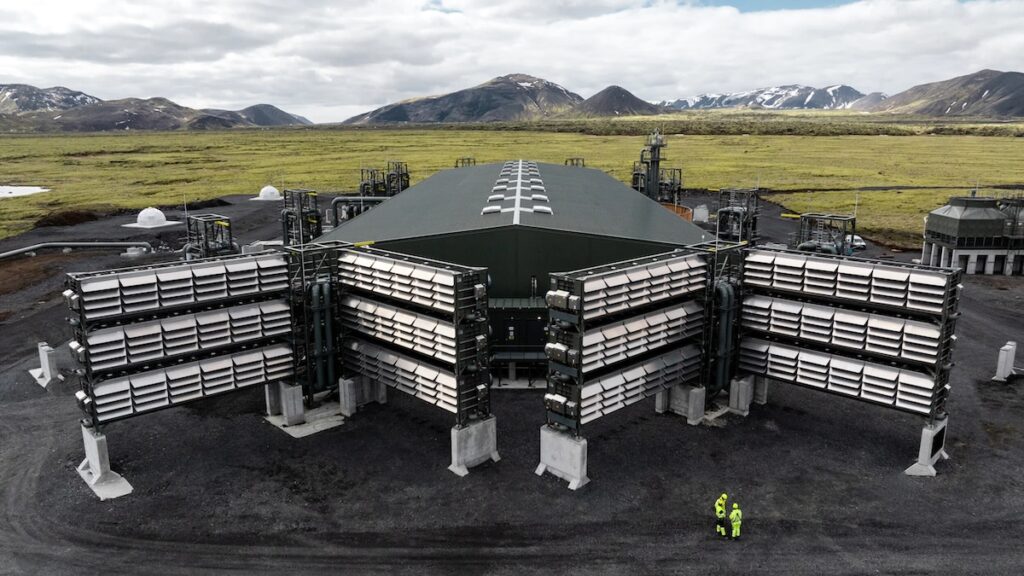World’s Largest CO2 Removal Plant Opens in Iceland
ENVIRONMENT, 20 May 2024
Cristen Hemingway Jaynes | EcoWatch - TRANSCEND Media Service

Mammoth, the world’s largest direct air capture and storage plant, in Hellisheiði, Iceland. Climeworks
9 May 2024 – Swiss company Climeworks has opened the biggest operational direct air capture (DAC) plant in the world to pull carbon dioxide from the atmosphere.
The Mammoth plant, located in Iceland, is nearly ten times bigger than Orca, its second-largest plant.
“Starting operations of our Mammoth plant is another proof point in Climeworks’ scale-up journey to megaton capacity by 2030 and gigaton by 2050,” said Jan Wurzbacher, Climeworks co-founder and co-CEO, in a press release from Climeworks.
The DAC process sucks carbon from the air and stores it, most often underground, where it can no longer contribute to global heating.
With global efforts to reduce fossil fuel emissions inadequate to prevent the worsening effects of climate change, United Nations scientists have estimated that carbon dioxide in the billions of tons will need to be removed to meet climate targets, reported Reuters.
Climeworks’ new DAC plant has an annual carbon capture capacity of 36,000 metric tons. The Mammoth plant, begun in 2022, will be completed by the end of this year.
The company’s first commercial DAC project was also in Iceland — the Orca plant — and has an annual capacity of 4,000 metric tons.
“Mammoth has successfully started to capture its first CO₂. Climeworks uses renewable energy to power its direct air capture process, which requires low-temperature heat like boiling water. The geothermal energy partner ON Power in Iceland provides the energy necessary for this process,” Climeworks said. “Once the CO₂ is released from the filters, storage partner Carbfix transports the CO₂ underground, where it reacts with basaltic rock through a natural process, which transforms into stone, and remains permanently stored.”
Critics of carbon capture technology argue that it uses an enormous amount of energy, is expensive and that focusing on the removal of carbon from the atmosphere could encourage companies to continue burning fossil fuels rather than lowering their emissions. Many critics also emphasize that its effectiveness has not been proven.
Speaking about carbon capture in general, Lili Fuhr, Center for International Environmental Law’s fossil economy program director, said the technology “is fraught with uncertainties and ecological risks,” as CNN reported.
The total carbon removal capacity on Earth can only remove roughly 0.01 million metric tons per year of the 70 million tons that would need to be removed by the end of the decade to meet worldwide climate goals, the International Energy Agency said.
Climeworks — which does not have ties to fossil fuel companies — said it is looking to lower the costs of DAC technology to $400 to $600 per ton by the end of the decade and $200 to $350 a ton by 2040, reported Reuters.
Development is currently in the works for megaton Climeworks hubs in the United States, the press release said.
______________________________________________
 Cristen Hemingway Jaynes is a writer of fiction and nonfiction. She holds a JD and an Ocean & Coastal Law Certificate from University of Oregon School of Law and an MA in Creative Writing from Birkbeck University of London. She is the author of the short story collection, The Smallest of Entryways, as well as the travel biography, Ernest’s Way: An International Journey through Hemingway’s Life.
Cristen Hemingway Jaynes is a writer of fiction and nonfiction. She holds a JD and an Ocean & Coastal Law Certificate from University of Oregon School of Law and an MA in Creative Writing from Birkbeck University of London. She is the author of the short story collection, The Smallest of Entryways, as well as the travel biography, Ernest’s Way: An International Journey through Hemingway’s Life.
Tags: CO2, Carbon footprint, Ecosystem, Environment, Iceland, Pollution, Switzerland
DISCLAIMER: The statements, views and opinions expressed in pieces republished here are solely those of the authors and do not necessarily represent those of TMS. In accordance with title 17 U.S.C. section 107, this material is distributed without profit to those who have expressed a prior interest in receiving the included information for research and educational purposes. TMS has no affiliation whatsoever with the originator of this article nor is TMS endorsed or sponsored by the originator. “GO TO ORIGINAL” links are provided as a convenience to our readers and allow for verification of authenticity. However, as originating pages are often updated by their originating host sites, the versions posted may not match the versions our readers view when clicking the “GO TO ORIGINAL” links. This site contains copyrighted material the use of which has not always been specifically authorized by the copyright owner. We are making such material available in our efforts to advance understanding of environmental, political, human rights, economic, democracy, scientific, and social justice issues, etc. We believe this constitutes a ‘fair use’ of any such copyrighted material as provided for in section 107 of the US Copyright Law. In accordance with Title 17 U.S.C. Section 107, the material on this site is distributed without profit to those who have expressed a prior interest in receiving the included information for research and educational purposes. For more information go to: http://www.law.cornell.edu/uscode/17/107.shtml. If you wish to use copyrighted material from this site for purposes of your own that go beyond ‘fair use’, you must obtain permission from the copyright owner.
Join the discussion!
We welcome debate and dissent, but personal — ad hominem — attacks (on authors, other users or any individual), abuse and defamatory language will not be tolerated. Nor will we tolerate attempts to deliberately disrupt discussions. We aim to maintain an inviting space to focus on intelligent interactions and debates.